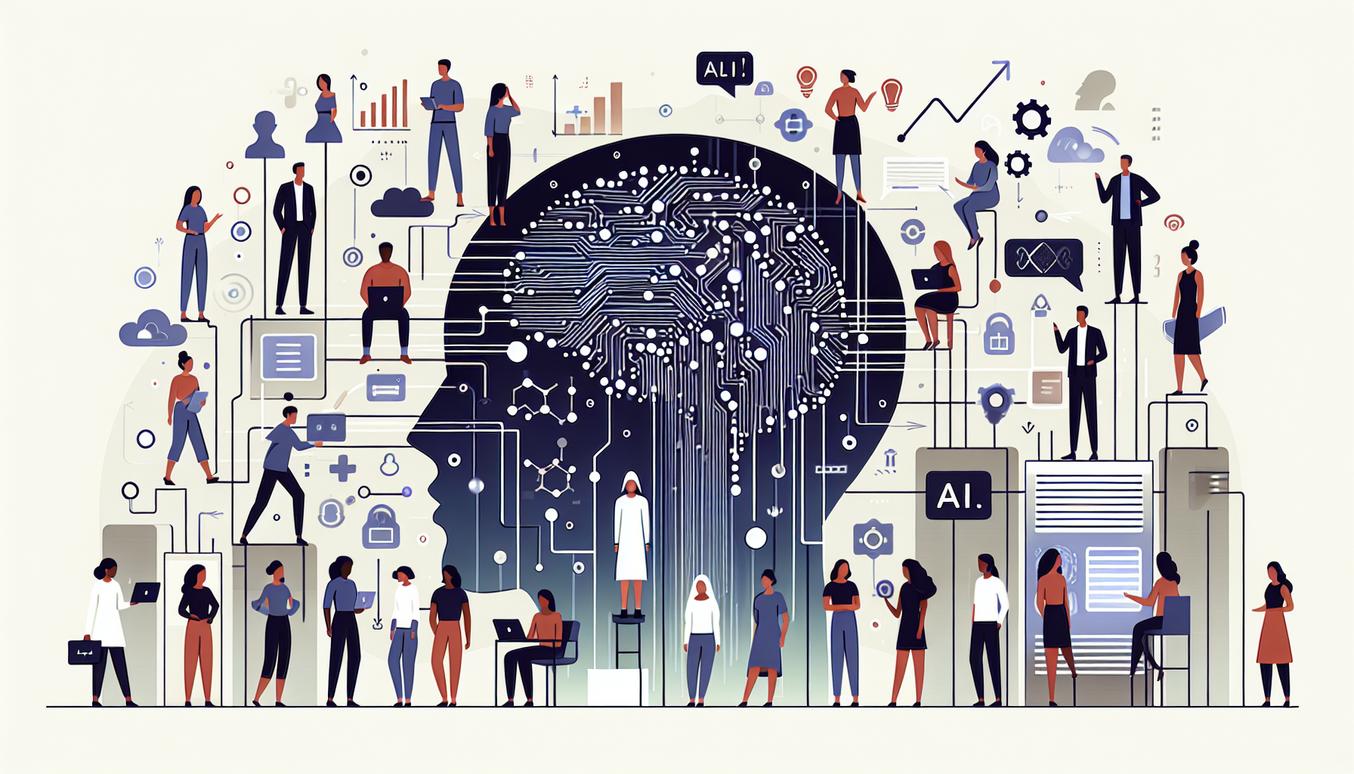A Leader’s Guide to AI Innovation: Strategy, Governance, and Practical Application
Table of Contents
- Introduction: Why AI Innovation Matters Today
- Defining AI Innovation: Concepts and a Practical Taxonomy
- Core Technologies: Neural Networks, Large Models, and Reinforcement Learning
- Capabilities and Limits: What Current Models Can and Cannot Do
- Responsible Design: Ethics, Fairness and Governance Checkpoints
- Engineering for Scale: Deployment Patterns and Operational Hygiene
- Security and Risk Management for AI Systems
- Measuring Value: Metrics, Benchmarks and KPIs
- Sector Templates: Healthcare and Finance Hypothetical Use Cases
- Roadmap: A 12 Month Plan for Responsible AI Initiatives
- Research Directions: Emerging Trends to Watch
- Conclusion: Practical Next Steps and Reflection
- Further Reading and Resources
Introduction: Why AI Innovation Matters Today
Artificial Intelligence (AI) has transcended its origins in academic research to become a foundational driver of economic and societal change. The rapid advancements in machine learning, particularly in the realm of large-scale models, have unlocked capabilities that were once the domain of science fiction. For technical leaders, product managers, and policymakers, understanding this landscape is no longer optional; it is a strategic imperative. True AI innovation is not merely about developing a new algorithm but about thoughtfully integrating these powerful tools to create novel products, streamline complex processes, and unlock new forms of value.
This whitepaper serves as a practical guide for navigating the complexities of AI adoption. It demystifies core technologies, provides frameworks for responsible implementation, and offers a clear roadmap for organizations seeking to harness the transformative potential of AI. Our goal is to bridge the gap between technical possibility and practical, value-driven application, enabling leaders to steer their AI innovation initiatives with confidence and foresight.
Defining AI Innovation: Concepts and a Practical Taxonomy
At its core, AI innovation refers to the creation and application of artificial intelligence to generate new value. This extends beyond the technology itself to encompass the novel business processes, user experiences, and strategic models that AI enables. To better understand its scope, we can categorize AI innovation into three distinct but often interconnected types:
A Practical Taxonomy
- Process Innovation: This involves applying AI to optimize, automate, or re-engineer internal business operations. The goal is typically to enhance efficiency, reduce costs, or improve quality. Examples include using predictive analytics for supply chain management, automating data entry with computer vision, or using Natural Language Processing to triage customer support tickets.
- Product and Service Innovation: This category focuses on embedding AI directly into customer-facing products and services. It can manifest as new features in existing products (e.g., personalized recommendations) or entirely new, AI-native offerings (e.g., generative art platforms or AI-powered diagnostic tools). This form of AI innovation directly shapes the user experience and can create significant competitive differentiation.
- Business Model Innovation: The most transformative category, this involves using AI to fundamentally alter how an organization creates, delivers, and captures value. This could mean shifting from selling a product to selling a predictive outcome (AI-as-a-Service), creating data-driven ecosystems, or enabling mass personalization at a scale previously unimaginable.
Core Technologies: Neural Networks, Large Models, and Reinforcement Learning
A foundational understanding of the core technologies is essential for any leader guiding an AI innovation strategy. While the field is vast, three concepts are particularly central to the current landscape.
Neural Networks
Inspired by the structure of the human brain, Artificial Neural Networks are the workhorse of modern machine learning. They are composed of interconnected layers of “neurons” (mathematical functions) that process information. By training on vast amounts of data, these networks learn to recognize patterns, make predictions, and classify information. They are the underlying architecture for most of the advanced models in use today.
Large Models (Generative AI and Foundation Models)
These are massive neural networks, often with billions or even trillions of parameters, trained on internet-scale datasets. Models like GPT-3, whose architecture was detailed in the paper “Language Models are Few-Shot Learners,” are a prime example of Generative AI. Their key characteristic is their ability to perform a wide range of tasks without task-specific training (zero-shot or few-shot learning). They can generate human-like text, write code, translate languages, and even reason about complex concepts, making them a powerful engine for AI innovation.
Reinforcement Learning (RL)
Reinforcement Learning is a paradigm where an AI agent learns to make decisions by performing actions in an environment to achieve a specific goal. The agent receives “rewards” or “penalties” for its actions, allowing it to learn the optimal strategy over time through trial and error. RL is particularly effective for dynamic, goal-oriented tasks such as robotic control, game playing, and optimizing complex logistical systems.
Capabilities and Limits: What Current Models Can and Cannot Do
Harnessing AI innovation effectively requires a sober assessment of both the remarkable capabilities and the critical limitations of current technologies. A failure to appreciate these boundaries can lead to misallocated resources, unrealistic expectations, and significant operational risks.
| Capabilities (What AI Excels At) | Limitations (Where AI Struggles) |
|---|---|
| Pattern Recognition at Scale: Analyzing vast datasets to identify subtle correlations and patterns invisible to humans. | Causal Reasoning: Understanding true cause-and-effect relationships rather than just correlation. |
| Content Generation: Creating coherent and contextually relevant text, images, and code based on prompts. | Commonsense Understanding: Lacking a deep, intuitive grasp of the physical and social world. |
| Prediction and Forecasting: Making statistically probable predictions based on historical data. | Generalization to Novel Situations: Struggling when faced with data or scenarios significantly different from its training data. |
| Optimization of Complex Systems: Finding optimal solutions in systems with many variables, such as logistics or network routing. | Factuality and “Hallucinations”: Generating plausible-sounding but factually incorrect or nonsensical information. |
Responsible Design: Ethics, Fairness and Governance Checkpoints
As AI systems become more autonomous and impactful, the need for a structured approach to ethics and governance is paramount. Responsible AI is a framework for developing and deploying AI systems that are fair, transparent, accountable, and aligned with human values. Integrating these principles from the outset is a prerequisite for sustainable AI innovation. The OECD AI Principles provide an excellent international standard for this work.
Essential Governance Checkpoints
- Data Provenance and Privacy: Ensure that training data is ethically sourced, representative, and respects privacy regulations. Maintain a clear chain of custody for all data assets.
- Bias and Fairness Audits: Proactively test models for demographic or social biases before and after deployment. Use fairness metrics to quantify and mitigate discriminatory outcomes.
- Model Transparency and Explainability (XAI): Where possible, use models that can explain their decisions. For black-box models, implement techniques like SHAP or LIME to provide post-hoc explanations, especially in high-stakes applications.
- Human-in-the-Loop (HITL): Design systems with clear points for human oversight, intervention, and final decision-making authority, particularly for critical or irreversible actions.
- Accountability and Redress: Establish clear lines of responsibility for AI system outcomes and create mechanisms for users to challenge or seek redress for adverse decisions made by an AI.
Engineering for Scale: Deployment Patterns and Operational Hygiene
A successful prototype is only the first step. Transitioning an AI model from a research environment to a robust, scalable production system requires disciplined engineering practices, often referred to as MLOps (Machine Learning Operations).
Common Deployment Patterns
- API-Based Services: The model is hosted on a central server and accessed via an API. This is common for web applications and allows for easy updates.
- Batch Processing: The model runs on a schedule to process large volumes of data offline. This is suitable for tasks like generating daily reports or updating risk scores.
- Edge Deployment: The model runs directly on a user’s device (e.g., a smartphone or IoT sensor). This provides low latency and enhances data privacy by keeping data local.
Operational Hygiene for AI
Strong operational hygiene ensures that AI systems are reliable, reproducible, and maintainable. Key practices include:
- Version Control: Track versions of not just code, but also datasets and trained models to ensure reproducibility.
- Continuous Monitoring: Actively monitor model performance, data drift, and infrastructure health in production to detect degradation or anomalies.
- Automated Pipelines: Automate the entire lifecycle of model training, testing, and deployment to increase speed and reduce human error.
Security and Risk Management for AI Systems
AI systems introduce novel security vulnerabilities that go beyond traditional cybersecurity. A proactive risk management strategy is essential to protect these valuable assets and mitigate potential harm.
Unique AI Security Risks
- Adversarial Attacks: Malicious actors can introduce carefully crafted, often imperceptible inputs to trick a model into making a wrong prediction.
- Data Poisoning: The integrity of a model can be compromised if an attacker manages to inject malicious data into its training set.
- Prompt Injection: A newer threat specific to large language models, where malicious instructions are hidden within a prompt to make the model override its original instructions.
* Model Inversion and Membership Inference: Attacks that attempt to extract sensitive training data or determine if a specific individual’s data was used to train the model.
Mitigation strategies include robust input validation, differential privacy techniques, anomaly detection on model inputs and outputs, and rigorous access controls for training data and model artifacts.
Measuring Value: Metrics, Benchmarks and KPIs
The success of an AI innovation initiative cannot be measured by technical metrics alone. While metrics like accuracy, precision, and recall are important for model development, they must be tied directly to business outcomes.
Bridging Technical and Business Metrics
- Define Success Before You Start: Work with stakeholders to define what a successful outcome looks like in business terms. Is the goal to reduce customer churn by 5%, increase lead conversion by 10%, or reduce manual review time by 40%?
- Establish Baselines: Measure the current state before implementing the AI solution. This baseline is critical for demonstrating a clear return on investment (ROI).
- Track Both Technical and Business KPIs: Monitor technical performance (e.g., model accuracy) alongside the target business KPIs. This connection proves the value of your AI innovation and helps justify future investment.
Sector Templates: Healthcare and Finance Hypothetical Use Cases
Applying these concepts to specific sectors can clarify their practical implications.
Healthcare: AI-Assisted Diagnostic Imaging
- The Innovation: A deep learning model that analyzes medical scans (e.g., X-rays, MRIs) to identify and highlight potential anomalies for review by a radiologist. This is a powerful example of process and product AI innovation.
- Business Value: Increased diagnostic throughput, reduced radiologist fatigue, and improved accuracy in early disease detection.
- Governance Checkpoints: Ensuring the model is trained on a diverse patient population to avoid demographic bias; validating its performance against clinical benchmarks; maintaining strict compliance with patient data privacy laws (e.g., HIPAA); and designing the workflow so the AI provides suggestions, but the human expert makes the final diagnosis.
Finance: AI-Powered Fraud Detection
- The Innovation: A real-time transaction monitoring system that uses anomaly detection to identify and flag potentially fraudulent activity with much higher accuracy and fewer false positives than rule-based systems.
- Business Value: Reduced financial losses from fraud, lower operational costs for manual reviews, and improved customer trust.
- Governance Checkpoints: Ensuring the system’s decisions are explainable to meet regulatory requirements (e.g., fair credit reporting); regularly auditing for biases that could disproportionately flag certain user groups; and implementing a clear and rapid process for customers to appeal a flagged transaction.
Roadmap: A 12 Month Plan for Responsible AI Initiatives
Embarking on an AI innovation journey requires a structured, phased approach. The following 12-month plan for 2025 provides a template for launching a responsible and value-driven initiative.
Phase 1: Foundation and Discovery (Months 1-3)
- Establish a Cross-Functional Team: Assemble a team including data scientists, engineers, product managers, legal experts, and business stakeholders.
- Identify High-Impact Use Cases: Brainstorm and prioritize potential AI projects based on feasibility, business value, and strategic alignment.
- Conduct Ethical Risk Assessments: For the top 1-2 use cases, perform an initial assessment of potential ethical risks, including fairness, privacy, and safety.
Phase 2: Pilot and Prototype (Months 4-6)
- Develop a Proof-of-Concept (PoC): Build a small-scale prototype for the chosen use case to validate technical feasibility.
- Establish MLOps Foundations: Implement basic version control for data and models and create a repeatable training pipeline.
- Implement Governance V1: Define initial data handling protocols and conduct a preliminary bias audit on the PoC model.
Phase 3: Scale and Integrate (Months 7-9)
- Refine the Model: Scale up the training data and refine the model architecture based on PoC learnings.
- Limited Deployment (Beta): Deploy the model to a controlled environment or a small group of internal users.
- Monitor Performance: Begin tracking both technical metrics and the target business KPIs in a real-world setting.
Phase 4: Optimize and Govern (Months 10-12)
- Full Rollout: Based on successful beta testing, deploy the solution more broadly.
- Formalize Governance: Establish a permanent AI governance council or review board.
- Plan for the Future: Use the learnings from this first initiative to build the roadmap for your 2026 AI innovation strategy.
Research Directions: Emerging Trends to Watch
The field of AI is evolving at an incredible pace. Leaders should keep an eye on emerging research directions that will shape the next wave of AI innovation.
- Multimodal AI: Systems that can seamlessly process and reason across different data types—text, images, audio, and more—will enable more sophisticated and context-aware applications.
- Federated Learning: A technique for training a shared model across multiple decentralized devices or servers without exchanging the raw data, offering a powerful solution for privacy-sensitive applications.
- Efficient AI (TinyML): The development of highly optimized models that can run on low-power, resource-constrained hardware, enabling powerful AI on edge devices.
- Neuro-symbolic AI: A hybrid approach that combines the pattern-recognition strengths of neural networks with the logical reasoning capabilities of classical symbolic AI, aiming to build more robust and commonsensical systems.
Conclusion: Practical Next Steps and Reflection
Successful AI innovation is not a purely technical endeavor; it is a socio-technical discipline that requires strategic vision, disciplined engineering, and a deep commitment to responsible practices. It is a journey of continuous learning and adaptation. By focusing on real business problems, building cross-functional teams, and embedding governance from the very beginning, organizations can move beyond the hype and unlock the profound, sustainable value of artificial intelligence.
Your journey begins not with a massive, multi-year project, but with a single, well-defined problem. Start there, build momentum, and foster a culture that views AI as a powerful tool for augmenting human ingenuity. This approach will provide the foundation for enduring and impactful AI innovation.
Further Reading and Resources
- Artificial Neural Networks: A detailed overview of the core concept from Wikipedia: https://en.wikipedia.org/wiki/Artificial_neural_network
- Generative AI and Large Language Models: The foundational GPT-3 paper, “Language Models are Few-Shot Learners”: https://arxiv.org/abs/2005.14165
- Responsible AI Principles: The OECD’s internationally recognized framework for trustworthy AI: https://www.oecd.org/going-digital/ai/principles/
- Natural Language Processing: An introduction to the field of AI focused on understanding and generating human language: https://en.wikipedia.org/wiki/Natural_language_processing









